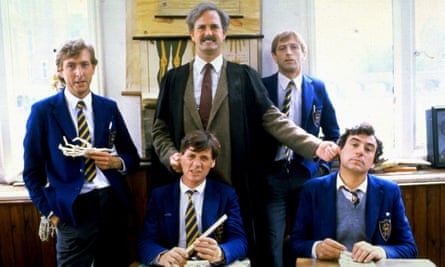Monty Python’s The Meaning of Life at 40: timeless sketch comedy brilliance
The troupe’s last feature as a six-person act is a smart and still relevant collection of satire and silliness
“Morning.”
“Morning.”
“What’s new?”
“Not much.”
“Hey look, Howard’s being eaten.”
These are the first lines – not counting the unofficial “short feature presentation” – in Monty Python’s The Meaning of Life, and a much more accurate reflection of the title than the hilariously tossed-off conclusion that ends the film, which advises to be nice to people, avoid eating fat and “read a good book every now and then”. The lines are exchanged by fish with human faces, swimming in circles around a tank at a restaurant, waiting for the day when they, too, are snatched up by God’s aquarium net like Howard. In the meantime, they splash around this limited space, exchanging pleasantries and trying not to think too much about what their mundane, meaningless, dread-filled lives are all about.

In what would be their last feature together as a six-person troupe, following Holy Grail and Life of Brian, Monty Python returned to the sketch comedy roots of Monty Python’s Flying Circus, which itself was anthologized in the 1971 film And Now for Something Completely Different. The sketch comedy movie is a notoriously difficult nut to crack, for the same reasons that haunt other anthologies: some bits are inevitably better than others, and the sum of those bits doesn’t usually add up to a cohesive whole. But no film has worked harder or succeeded more than The Meaning of Life to hold the chapters to a high comedy standard and bring them together under a smart, prismatic conceit that really does seek to comment on the big questions in a meaningful way – even if the basic message is to look to the stars, because “there’s bugger all on Earth”.
Forty years later, The Meaning of Life feels timeless by design, because its sketches are not tied to inside jokes or up-to-the-minute cultural references, but more longstanding existential miseries. The Terry Gilliam “short feature” that prefaces the film, The Crimson Permanent Assurance, feels conspicuously disconnected from it, but it’s also a fascinating dry run for Gilliam’s Brazil two years later, staging a bureaucratic revolt by elderly accountants as if it were an old-fashioned swashbuckler. But that’s a mere throat-clearing for a 90-minute progression through life’s various stages that touches on birth, death and the afterlife, and all the grim little pitstops we take along the way.
The troupe’s Swiftian instinct to satirize society’s biggest issues contributes to the film’s eternal relevance, though they do reserve a special contempt for religious dogma and the supervisory class and the archetypical British stiffs who tend to represent these institutions. The inspired two-part first chapter, on “The Miracle of Birth”, parodies the unnatural apparatus of hospital births, so heavily mediated by expensive equipment (like the machine that goes “ping”) that the mother and child are irritating afterthoughts. That leads naturally to another burdensome form of motherhood in “Third World” Yorkshire, as a house full of kids, according to Roman Catholic dictates on birth control, sings a chorus of Every Sperm is Sacred before getting sold off by their unemployed dad for scientific experiments.
Of the stars, John Cleese and Michael Palin get the greatest showcase here, with Cleese stiffening his upper lip as a boarding school instructor who illustrates a sexual education lesson by popping a Murphy bed from the classroom wall and having intercourse with his wife. The formality of the language is the joke here – “The penis is, now you will observe, more or less fully erect” – but the scene doubles as a parody of marriage and the rituals that end in another perfunctory roll in the hay. In a chapter on Middle Age, Cleese also pokes at the reluctance people feel to ever talk about the big existential questions, playing a waiter who offers a menu of conversation topics (“Our special tonight is minorities”) before landing on “philosophy”, which his daft customers find thoroughly unappealing. A “viable hypothesis to explain the meaning of life?” Send it back to the kitchen, please.
A section on war and the military pokes at British colonialism and military hierarchies, as frontline grunts die in the trenches while celebrating their captain’s birthday and the search for another officer’s missing leg involves his underlings apologizing for all the dead bodies they have to step over first. But it’s Palin who gets one of the funniest gags in the film as a sergeant major who bellows at his men, “Does anyone have anything they’d rather be doing than marching up and down the square?” and finds that all of them do, in fact, have better options. It’s another example of The Meaning of Life understanding humans as fish in the tank, marching pointlessly within the parameters imposed on them by the government, by religion and by their own conformist mindset.

For all the pitfalls of the anthology format, Monty Python seizes the chance to launch a multi-front attack on societal institutions and philosophical precepts while also leaving room for silliness and juvenilia. To mark “The Middle of the Film” they stage a bizarre acid trip called Find the Fish involving Graham Chapman in drag, Terry Jones as a mustachioed figure with long arms, and a green elephant butler. Elsewhere, a couple of saw-wielding goons collect a liver from a still-living donor and a death penalty recipient gets to choose his manner of execution, which involves naked women in helmets chasing him off a cliff.
Perhaps fittingly, the sketch with the most staying power is also the crudest, with the gluttonous Mr Creosote (Jones) walking into a fine dining restaurant and projectile vomiting his way through a meal. (If you’ve ever been offered a light dessert after a heavy meal, think of poor Mr Creosote and his “wafer-thin mint”.) In satire and glorious song, The Meaning of Life tackles the full spectrum of human existence, with its petty hassles and profound mysteries. It also features a very large man vomiting. Sometimes we need our dumb distractions.



